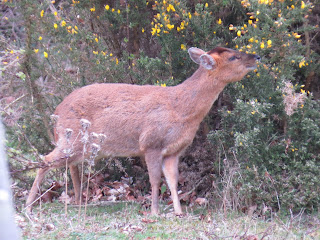 |
| Sand Martins |
I'm back at Minsmere again with Mum to see what spring migrants have arrived this month at this famous reserve. As soon as I got out of the car, I had my answer flying over me in the form of sand martins. The sand cliff opposite the visitor centre was buzzing with these sandy brown birds commuting back and forth to their nesting holes in the bank. There were hundreds of them! They are busy paring up and cleaning out their chosen nest site from last year's nesting season at the moment after returning from their migration from Africa. I could watch them all day, but we have a long walk ahead of us around the rest of the reserve.
 |
| How many can you see? |
 |
| Yellow Wagtail |
From North Hide, our second migrant of the day was a real gem. A yellow wagtail was on the look out for a meal in the newly sprouting reedbed between a couple of wooden posts. Though it was at a bit of a distance for my camera, you can clearly see how yellow it is amongst the freshly green shoots and leaves of the young reeds. There are many races of yellow wagtail across Europe with some having blue or black heads, but it is the British race that is yellow all over like a little canary. Like all wagtails, they have a habit of waging their tails up and down all the time, which just adds to their colourful character. As with most farmland bird species in the UK, they are massively declining and it would be a shame to lose such a cheery-looking bird. But if you want to see one for yourself, check a field of livestock near you and you should be lucky enough to find one following the sheep or cattle around for an easy meal of flies.
 |
| Lapwing |
 |
| Stone-curlew (can you see it?) |
As we walked down towards the beach, the path takes us past a rabbit infested field that closely resembles that of the Brecklands in west Norfolk and Suffolk. This is a perfect landscape for stone-curlews and sure enough there were people looking at them through telescopes. They were a long way off and there was a bit of a haze, but you can see them in these dodgy shots. Look to the right of the black tube-thing and between where grass and stoney ground meets. Can you see them? It just goes to show you how well camouflaged these birds are. They are summer visitors and are very rare in the UK with Minsmere and the Brecks being the best places to see them. Stone-curlews are strange looking birds, about chicken sized with long yellow legs and large goggle-like yellow eyes. They are masters of hide and seek in open countryside for a bird of their size. I always feel lucky after I see one.
 |
| Linnet |
Along the beach as we were walking to our next hide, a pair of linnets and stonechats stopped us in our tracks as they were feeding in the shingle and patches of grass in front of us. The stonechats were also posing on the fence beside us. Both species were very bold indeed. We did manage to reach the hide in the end, right after seeing a pair of Cetti's warblers shouting at us. From the scrapes, there were hundreds of black-headed gulls everywhere, as they prepared their nest site next to their many noisy neighbours. Avocets, godwits, redshanks, ringed plovers and oystercatchers were also all present as they continued to feed or began to sit on eggs on their simple scrape of nest.
 |
| Stonechat |
 |
| Avocet |
 |
| Avocet and Oystercatcher |
 |
| Barnacle Goose |
 |
| Turnstone |
 |
| Black-tailed Godwit |
 |
| Black-headed Gulls |
 |
| Redshank |
 |
| Ringed Plover |
 |
| Marsh Harrier |
One sound you could hear throughout the reserve were of bitterns booming. We could hear them from the beach, but the sound was at its best closer to Bittern Hide. It sounded like someone blowing over the top of an old glass milk bottle, but the low frequency was powerful enough to vibrate your body at close range. Unfortunately, I couldn't see any today, but I did see marsh harriers instead.
 |
| Wren |
 |
| Treecreeper |
After lunch, we walked to Island Mere Hide via the hill where the Springwatch building is. Green woodpeckers were yaffling very closeby, but I couldn't see any. My first cuckoo of the year was calling even further away in this landscape, I couldn't see him either. There wasn't much to see at Island Mere Hide besides marsh harriers, swallows, a great crested grebe and some gulls. So we walked back to Bittern Hide, seeing a treecreeper and two muntjac deer along the way. We also saw blackcaps and chiffchaffs to add to our migrant list for today. Not a bad visit, though I wish the sun broke through the thick clouds to warm us up a bit.
 |
| Muntjac Deer |
 |
| Grey Squirrel |




















































No comments:
Post a Comment